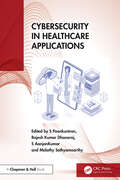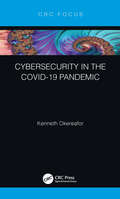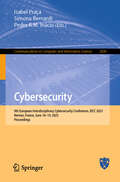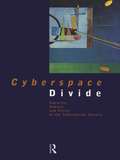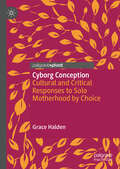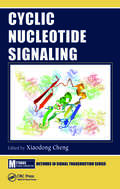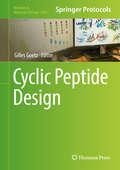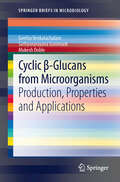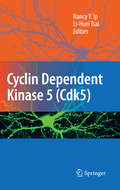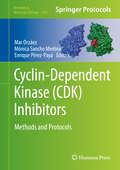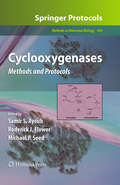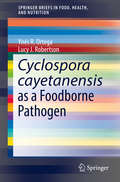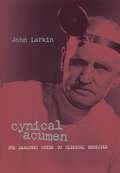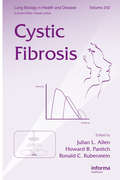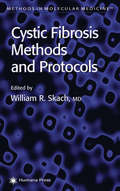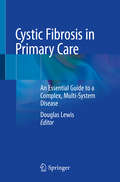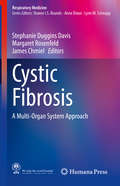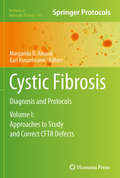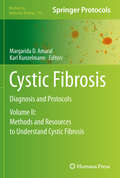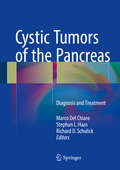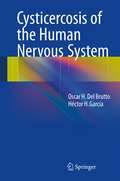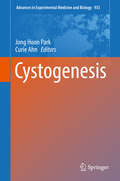- Table View
- List View
Cybersecurity in Healthcare Applications
by Rajesh Kumar Dhanaraj S. Poonkuntran S. Aanjankumar Malathy SathyamoothyThe book explores the critical challenge of securing sensitive medical data in the face of rising cyber threats. It examines how artificial intelligence can be leveraged to detect and mitigate cyber threats in healthcare environments. It integrates advanced technologies such as AI security applications, blockchain techniques, cryptanalysis, and 5G security to strengthen the protection of healthcare systems. By offering insights into the latest vulnerability assessment technologies and effective protection strategies, this book serves as an essential resource for professionals and researchers dedicated to enhancing cyber security in the healthcare industry.
Cybersecurity in the COVID-19 Pandemic
by Kenneth OkereaforAs the 2020 global lockdown became a universal strategy to control the COVID-19 pandemic, social distancing triggered a massive reliance on online and cyberspace alternatives and switched the world to the digital economy. Despite their effectiveness for remote work and online interactions, cyberspace alternatives ignited several Cybersecurity challenges. Malicious hackers capitalized on global anxiety and launched cyberattacks against unsuspecting victims. Internet fraudsters exploited human and system vulnerabilities and impacted data integrity, privacy, and digital behaviour. Cybersecurity in the COVID-19 Pandemic demystifies Cybersecurity concepts using real-world cybercrime incidents from the pandemic to illustrate how threat actors perpetrated computer fraud against valuable information assets particularly healthcare, financial, commercial, travel, academic, and social networking data. The book simplifies the socio-technical aspects of Cybersecurity and draws valuable lessons from the impacts COVID-19 cyberattacks exerted on computer networks, online portals, and databases. The book also predicts the fusion of Cybersecurity into Artificial Intelligence and Big Data Analytics, the two emerging domains that will potentially dominate and redefine post-pandemic Cybersecurity research and innovations between 2021 and 2025. The book’s primary audience is individual and corporate cyberspace consumers across all professions intending to update their Cybersecurity knowledge for detecting, preventing, responding to, and recovering from computer crimes. Cybersecurity in the COVID-19 Pandemic is ideal for information officers, data managers, business and risk administrators, technology scholars, Cybersecurity experts and researchers, and information technology practitioners. Readers will draw lessons for protecting their digital assets from email phishing fraud, social engineering scams, malware campaigns, and website hijacks.
Cybersecurity: 9th European Interdisciplinary Cybersecurity Conference, EICC 2025, Rennes, France, June 18–19, 2025, Proceedings (Communications in Computer and Information Science #2500)
by Simona Bernardi Isabel Praça Pedro R.M. InácioThis book constitutes the proceedings of the 9th European Interdisciplinary Cybersecurity Conference, EICC 2025, which took place in Rennes, France, during June 18–19, 2025. The 21 full papers and 2 short papers included in these proveedings were carefully reviewed and selected from 39 submissions. They were organized in topical sections as follows: Artificial intelligence applied to cybersecurity; cybercrime and cyberthreats; cybersecurity; software development security; advances in interdisciplinary cybersecurity: insights from funded reserach projects - CyFRP 2025 special session; complex network analysis for cybersecurity - CNACYS 2025 special session; medical device security and privacy - MeDSec 2025 special session; MDCG guidance; threshold multiparty private set intersection.
Cyberspace Divide: Equality, Agency and Policy in the Information Society
by Brian D. LoaderThe dramatic advances in computer and telecommunications technologies such as the Internet, virtual reality, smart cards or multimedia applications are increasingly regarded as ushering in a new form of society: the information society. Politicians, policy makers and business gurus are all encouraging us to join the information superhighway at the nearest junction or risk being excluded from the social and economic benefits of the information revolution. Cyberspace Divide critically considers the complex relationship between technological change, its effect upon social divisions, its consequences for social action and the emerging strategies for social inclusion in the Information Age. Cyberspace Divide will be invaluable reading for those studying social policy, sociology, computing and communication studies.
Cyborg Conception: Cultural and Critical Responses to Solo Motherhood by Choice
by Grace HaldenThis book considers the growing popularity of solo motherhood via gamete donation and how this type of “cyborg conception” is narrated in medicine, bioethics, fiction, and memoir. It identifies solo mothers as radical women who exist in a space beyond binarity (male/female dual-rearing dynamic) and heteronormative discourse; solo mothers represent, among other diverse family constructions (such as same-sex couples and throuples), a critical intervention in the dominant narrative of the nuclear family which defines the “ideal” reproductive model. This book combines memoir and scholarly research to present a deeply nuanced and rigorous overview of the solo motherhood phenomenon.
Cyclic Nucleotide Phosphodiesterases in Health and Disease
by Miles D. Houslay Sharron H. Francis Joseph A. BeavoSince the last major compendium dedicated to cyclic nucleotide phosphodiesterases (PDEs) was published over 15 years ago, an enormous amount of progress has occurred in the field. There is great need for a centralized source for key information in this burgeoning and therapeutically important area of medical research. Cyclic Nucleotide Phosph
Cyclic Nucleotide Signaling (Methods in Signal Transduction Series)
by Xiaodong ChengShowcasing the recent progresses of the field, Cyclic Nucleotide Signaling covers the major tools and methodologies used in various areas of research. The majority of the chapters are protocol oriented, with the goal of providing clear directions for laboratory use. Students and investigators new to the field will find this book particularly inform
Cyclic Peptide Design (Methods in Molecular Biology #2001)
by Gilles GoetzThis book covers strategies to improve cell permeability, intestinal permeability, and metabolic stability, which are the typical liabilities associated with cyclic peptides, to enhance protein-protein recognition, and to build upon nature’s cyclic peptides and macrocycles. Chapters also cover key peptide screening and display strategies, as well as important synthetic approaches towards cyclic and helical peptides. Cyclic peptides have become of significant importance as chemical tools in biology and drug discovery, since this class of chemicals has become a credible alternative source of new drug leads on par with traditional small molecules. As a part of the Methods in Molecular Biology series, this collection includes the kind of detail and implementation advice to aid researchers in the field. Authoritative and cutting-edge, Cyclic Peptide Design serves as a critical resource and go-to reference for researchers within the pharmaceutical industry, as well as scientists and students in the bioorganic, medicinal, and natural product chemistry fields.
Cyclic β-Glucans from Microorganisms: Production, Properties and Applications (SpringerBriefs in Microbiology #0)
by Sathyanarayana Gummadi Mukesh Doble Geetha Venkatachalamto Cyclic glucans are polysaccharides that are predominantly produced by Agrobacterium, Bradyrhizobium and Rhizobium sp. and widely used in the pharmaceutical and food industries. In this book, the applications, properties, analytical tools, production and genes of four main cyclic β-glucans from microorganisms are highlighted and critically evaluated. As biocompatible and biodegradable renewable resources, they have an immense potential for future applications, which has not yet been fully exploited. This concise review will help to bridge this gap.
Cyclic-Nucleotide Phosphodiesterases in the Central Nervous System
by Anthony R. West Nicholas J. BrandonThis book reviews advances in understanding phosphodiesterases within the central nervous system and their therapeutic applications. A range of expert authors from both academia and industry describe these, then focus on the areas of greatest scientific and medical interest to provide more detailed coverage. Therapeutic and drug discovery applications are covered for diseases including Alzheimer's, Parkinson's, schizophrenia, erectile dysfunction, and spinal cord injuries. There is also a chapter on drug discovery tools such as in vitro assays and X-ray structures for medicinal chemistry studies.
Cyclin Dependent Kinase 5 (Cdk5)
by Nancy Y. Ip Li-Huei TsaiCyclin Dependent Kinase 5 provides a comprehensive and up-to-date collection of reviews on the discovery, signaling mechanisms and functions of Cdk5, as well as the potential implication of Cdk5 in the treatment of neurodegenerative diseases. Since the identification of this unique member of the Cdk family, Cdk5 has emerged as one of the most important signal transduction mediators in the development, maintenance and fine-tuning of neuronal functions and networking. Further studies have revealed that Cdk5 is also associated with the regulation of neuronal survival during both developmental stages and in neurodegenerative diseases. These observations indicate that precise control of Cdk5 is essential for the regulation of neuronal survival. The pivotal role Cdk5 appears to play in both the regulation of neuronal survival and synaptic functions thus raises the interesting possibility that Cdk5 inhibitors may serve as therapeutic treatment for a number of neurodegenerative diseases.
Cyclin-Dependent Kinase: Methods and Protocols (Methods in Molecular Biology #1336)
by Mar Orzáez Mónica Sancho Medina Enrique Pérez-PayáThis volume contains a collection of relevant information for drug discovery in cell cycle research. Protocols to develop screening assays or to identify novel CDK inhibitors are discussed in the first part of the book. The second part of the book describes elaborate procedures to evaluate activity and mechanism of action of new and already identified CDK inhibitors. The third part of the book talks about protocols to evaluate metabolomics changes associated to inhibitor treatment. Drug delivery strategies focused on nanoparticle development to provide alternative internalization systems for increasing inhibitor efficacy are also described. Written in the highly successful Methods in Molecular Biology series format, chapters include introductions to their respective topics, lists of the necessary materials and reagents, step-by-step, readily reproducible laboratory protocols, and tips on troubleshooting and avoiding known pitfalls.Authoritative and thorough, Cyclin-Dependent Kinase (CDK) Inhibitors: Methods and Protocols is a useful tool for scientists interested in this research field.
Cyclooxygenases: Methods and Protocols (Methods in Molecular Biology #644)
by Samir S. Ayoub Roderick J. Flower Michael SeedSince the discovery of the pharmacological and toxicological importance of inhibiting the cyclooxygenase (COX) enzymes by non-steroidal anti-inflammatory drugs (NSAIDs), much research has gone into the development of methods to study the biological functions of COX-1 and COX-2. In Cyclooxygenases: Methods and Protocols, experts and pioneers in the field present the most up-to-date in vitro and in vivo techniques routinely used in COX research. The volume delves into essential topics such as the purification, cloning, and expression of COX enzymes as well as in vitro assays aimed at determining the inhibitory potency of drugs on COX-1 and COX-2 activities, with chapters describing protocols used for the extraction and measurement of the prostanoids. This volume also describes in vivo disease models used to study the roles of COX-1 and COX-2 in gastrointestinal injury, inflammation, and pain. As a book in the highly successful Methods in Molecular BiologyTM series, the protocols chapters include brief introductions to their respective topics, lists of the necessary materials and reagents, step-by-step, readily reproducible laboratory protocols, and notes on troubleshooting and avoiding known pitfalls. Authoritative and cutting-edge, Cyclooxygenases: Methods and Protocols serves as an indispensable tool for all scientists seeking the treatment of inflammation, pain, fever, and other harmful conditions.
Cyclospora cayetanensis as a Foodborne Pathogen (SpringerBriefs in Food, Health, and Nutrition)
by Lucy J. Robertson Ynés R. OrtegaThis Brief provides a comprehensive overview of Cyclospora cayetanensis, a protozoan apicomplexan parasite that leads to outbreaks of traveler's diarrhea in consumers. The main characteristics of Cyclospora cayetanensis infection are covered, including documented outbreaks, regional patterns and statistics. Various transmission routes for this parasite are outlined, with a focus on foodborne transmission. A major focus of Cyclospora Cayetanensis As A Foodborne Pathogen is the detection of Cyclospora cayetanensis in different food matrices. Decontamination procedures for the occurrence of this parasite in all major food types are outlined in detail, as well as current risk assessment procedures and regulations. The difficulty in minimizing the risk of infection in fresh produce is covered, plus potential solutions for this problem. This Brief not only comprehensively covers the current state of foodborne Cyclospora cayetanensis but also looks to future challenges in the detection, prevention and removal of this parasite in foods.
Cynical Acumen: The Anarchic Guide to Clinical Medicine
by John LarkinWinner of the Medical Journalists' Association Specialist Book of the Year Award 2006 Cynical Acumen approaches medicine in the real world, dealing with issues ignored by other books. It is a unique, 'what you really need to know' textbook designed to help medical students and senior house officers look slick and pass their exams against all odds. The book entertainingly considers the world outside medicine with anecdotes on the important things in life such as sport, literature, Thai cooking and the dissolution of the monasteries. It has been aptly described by the author as 'The Hitchhiker's Guide to Medicine'. Medical students will find this underground resource invaluable, as will medical professionals including junior hospital doctors, particularly those sitting the MRCP examination.
Cystic Fibrosis (Lung Biology in Health and Disease)
by Julian L. Allen Howard B. Panitch Ronald C. RubensteinThe median age of survival for those with cystic fibrosis has risen considerably in recent years. This text thoroughly examines the developments and breakthroughs which have led to this improvement in life expectancy. With a focus on the latest discoveries in the diagnosis and treatment of the disease, this book provides a comprehensive overview of
Cystic Fibrosis Methods and Protocols (Methods in Molecular Medicine #70)
by William R. SkachCystic Fibrosis: Methods and Protocols consolidates cutting-edge in vitro, cellular, and whole animal laboratory protocols into an indispensable resource. From electrophysiology and cell biology, to animal models and gene therapy, this comprehensive set of methods provides the step-by-step instructions needed for investigators to incorporate new approaches into their research programs. Specific protocols describe new techniques for diagnosis, in vitro methods for the expression and functional analysis of CFTR, novel biochemical and cellular systems to determine how mutations subvert CFTR function, and in vivo protocols to examine how CFTR dysfunction produce multisystem pathology in both human and animal models.
Cystic Fibrosis in Primary Care: An Essential Guide to a Complex, Multi-System Disease
by Douglas LewisCystic fibrosis is a disease that affects the entire body. It tends to be thought of as primarily a pulmonary disease since pulmonary decline is the main factor in early mortality. Because of the multi-system nature of the disease, a better understanding of cystic fibrosis expands the family physician's understanding of subjects ranging from genetics to pulmonary function to nutrition to colon transport to hydration to electrolyte management. The primary care philosophy is unique in that it always considers how a narrow problem can affect an individual globally. Cystic Fibrosis care can often feel fractured to patients as they are sent to multiple specialists to deal with problems outside of the comfort level of a prior or current specialist. With a broad medical philosophy, care is more inclusive as clinicians can manage topics such as diabetes and preventive care without multiple referrals and additional appointments. Family physicians are well-positioned and well-qualified to competently meet many of the care needs of those with cystic fibrosis. This book is edited by a family medicine physician who has specialist level experience with the disease. It opens with a background on cystic fibrosis foundations and centers to familiarize the reader. The next chapter gives a basic overview of the disease. Each of the subsequent chapters provide a comprehensive look at how cystic fibrosis affects other areas of the body that the primary care physician should be familiar with. Major components of cystic fibrosis such as physiology, spirometry, inflammation, airway clearance, chronic infection, cystic fibrosis related diabetes and pancreatic insufficiency, among others, are thoroughly explained. Written by experts in the field, Cystic Fibrosis in Primary Care appeals to all family physicians as well as specialists, residents, medical students physician assistants and nurse practitioners alike.
Cystic Fibrosis: A Multi-Organ System Approach (Respiratory Medicine)
by Stephanie Duggins Davis Margaret Rosenfeld James ChmielThis book provides a comprehensive overview of the multisystem disease, cystic fibrosis, for both pediatric and adult patients. Written by experts in the field, the text outlines the progressive nature of CF as well as the impact of this autosomal recessive disease on the respiratory, gastrointestinal, endocrine, rheumatologic, and renal systems, as well as the patient’s mental health. The book begins with a chapter describing the history of cystic fibrosis and how the face of this life-shortening disease has changed over the past several decades. The following chapters elucidate the pathophysiology of how cystic fibrosis impacts each organ system. Current management and therapeutics are detailed with step-by-step guidelines for clinicians. This book is unique in that it highlights the entire person, not just the respiratory system, with detailed inclusion of the patient perspectives throughout, informing practice standards and considerations. This is an ideal guide for pediatric and adult physicians who care for patients with cystic fibrosis, as well as respiratory therapists, physical therapists, nurses, nutritionists, and pharmacists who care for these patients.
Cystic Fibrosis: Diagnosis and Protocols, Volume I: Approaches to Study and Correct CFTR Defects (Methods in Molecular Biology #741)
by Karl Kunzelmann Margarida D. AmaralDespite the many milestones in cystic fibrosis (CF) research, progress towards curing the disease has been slow, and it is increasingly difficult to grasp and use the already wide and still growing range of diverse methods currently employed to study CF so as to understand it in its multidisciplinary nature. Cystic Fibrosis: Diagnosis and Protocols aims to provide the CF research community and related researchers with a very wide range of high-quality experimental tools, as an easy way to grasp and use classical and novel methods applied to cystic fibrosis. Volume I: Approaches to Study and Correct CFTR Defects focuses on the cystic fibrosis transmembrane conductance regulator (CFTR) and its expression, biogenesis, structure, and function in terms of the defects causing CF. Written in the highly successful Methods in Molecular BiologyTM series format, chapters include introductions to their respective topics, lists of the necessary materials and reagents, step-by-step, readily reproducible laboratory protocols, and tips on troubleshooting and avoiding known pitfalls. Comprehensive and practical, Cystic Fibrosis: Diagnosis and Protocols will provide readers with optimal working tools to address pressing questions in the best technical way, while helping all of us, as a research and clinical community, to move faster hand-in-hand toward unravelling the secrets of this challenging disorder and cure it.
Cystic Fibrosis: Diagnosis and Protocols, Volume II: Methods and Resources to Understand Cystic Fibrosis (Methods in Molecular Biology #742)
by Karl Kunzelmann Margarida D. AmaralDespite the many milestones in cystic fibrosis (CF) research, progress toward curing the disease has been slow, and it is increasingly difficult to grasp and use the already wide and still growing range of diverse methods currently employed to study CF so as to understand it in its multidisciplinary nature. Cystic Fibrosis: Diagnosis and Protocols aims to provide the CF research community and related researchers with a very wide range of high-quality experimental tools, as an easy way to grasp and use classical and novel methods applied to cystic fibrosis. Volume II: Methods and Resources to Understand Cystic Fibrosis focuses on pathophysiology, Omics approaches, and a variety of key resources recently made available for CF research. Written in the highly successful Methods in Molecular BiologyTM series format, chapters include introductions to their respective topics, lists of the necessary materials and reagents, step-by-step, readily reproducible laboratory protocols, and tips on troubleshooting and avoiding known pitfalls. Comprehensive and practical, Cystic Fibrosis: Diagnosis and Protocols will provide readers with optimal working tools to address pressing questions in the best technical way, while helping all of us, as a research and clinical community, to move faster hand-in-hand toward unravelling the secrets of this challenging disorder and cure it.
Cystic Tumors of the Pancreas: Diagnosis and Treatment
by Marco Del Chiaro Stephan L. L. Haas Richard D. D. SchulickThis book provides a detailed, up-to-date overview of cystic tumors of the pancreas, with coverage of all aspects of diagnosis and treatment (medical, endoscopic, and surgical). After opening chapters on pathology and classification, cytology, molecular biology, and epidemiology, the role of each of the relevant diagnostic methods is carefully examined. The treatment-related chapters describe surgical approaches, including minimally invasive surgery, as well as ablation modalities and chemo-radiotherapy. Thorough guidance is also provided specifically on the management of cystic tumors in high-risk cases and on follow-up. The authors are global opinion leaders in their field who have contributed cutting-edge chapters, with emphasis on clear diagnostic and therapeutic algorithms and with numerous supporting tables and illustrations. Owing to the widespread use of imaging modalities, clinicians are being confronted by an increasing number of patients with cystic tumors of the pancreas, ranging from benign cysts to metastasized malignancies. The widening spectrum of available diagnostic measures has resulted in controversy over the choice of further means of investigation when cystic changes are encountered, and the growth in therapeutic options has similarly been accompanied by considerable debate over their use. Against this background, Cystic Tumors of the Pancreas will be a valuable source of relevant information for both clinicians and surgeons and will also be of interest to radiologists, pathologists, and basic scientists.
Cysticercosis of the Human Nervous System
by Héctor H. García Oscar H. Del BruttoNeurocysticercosis (neural infection by larvae of Taenia solium) occurs when humans become intermediate hosts of the tapeworm Taenia solium after ingesting its eggs. The disease is now the most common helminthic infection of the nervous system in humans, and its prevalence has risen significantly even in countries where it was formerly considered exotic. The introduction of modern neuroimaging and serologic techniques has improved the diagnosis of neurocysticercosis; furthermore, the development of potent cysticidal drugs has changed the prognosis of most affected patients. Nevertheless, much remains to be learned about this parasitic disease. This book provides a comprehensive and up-to-date review of the various aspects of cysticercosis of the nervous system that will be of interest to all who are involved in the care of patients with this disease. Epidemiology, neuropathology, immunopathogenesis, clinical manifestations, diagnosis, and management are all thoroughly discussed based on current evidence and practice.
Cystogenesis (Advances in Experimental Medicine and Biology #933)
by Jong Hoon Park Curie AhnAutosomal Dominant Polycystic Kidney Disease (ADPKD) is a highly prevalent hereditary renal disorder in which fluid-filled cysts are appeared in both kidneys. Main causative genes of ADPKD are PKD1 and PKD2, encoding for polycystin-1 (PC1) and polycystin-2 (PC2) respectively. Those proteins are localized on primary cilia and function as mechanosensor in response to the fluid flow, translating mechanistic stimuli into calcium signaling. With mutations either of PKD1 or PKD2, hyper-activated renal tubular epithelial cell proliferation is observed, followed by disrupted calcium homeostasis and aberrant intracellular cyclic AMP (cAMP) accumulation. Increased cell proliferation with fluid secretion leads to the development of thousands of epithelial-lined, fluid-filled cysts in kidneys. It is also accompanied by interstitial inflammation, fibrosis, and finally reaching end-stage renal disease (ESRD). In human ADPKD, the age at which renal failure typically occurs is later in life, however no specific targeted medications are available to cure ADPKD. Recently, potential therapeutic targets or surrogate diagnostic biomarkers for ADPKD are proposed with the advances in the understanding of ADPKD pathogenesis, and some of them were attempted for clinical trials. Herein, we will summarize genetic and epi-genetic molecular mechanisms in ADPKD progression, and overview the currently available biomarkers or potential therapeutic reagents suggested.
Cystoid Macular Edema: Medical and Surgical Management
by Shlomit Schaal Henry J. KaplanWritten for comprehensive ophthalmologists and vitreoretinal surgeons, this book discusses state-of-the-art medical and surgical management of cystoid macular edema (CME) and explains the current understanding of the pathophysiology of the condition and methods of diagnosis. The management approach is clearly detailed for each potential presentation, including CME occurring in association with uveitis, diabetes mellitus, vitreoretinal interface changes, retinal vascular occlusions, and lens-induced pathology. The guidance takes full account of the continued expansion in medical treatment options due to the development of new drugs and the increased availability of minimally invasive surgical procedures. Additionally, since therapeutic approaches to CME depend on a clear understanding of pathophysiologic mechanisms and the structural changes in the vitreous and neurosensory retina revealed by imaging studies, these aspects are carefully considered as well.
